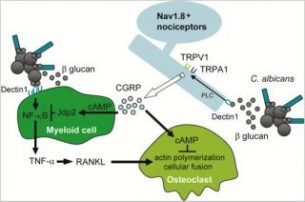- Home
- Editorial
- News
- Practice Guidelines
- Anesthesiology Guidelines
- Cancer Guidelines
- Cardiac Sciences Guidelines
- Critical Care Guidelines
- Dentistry Guidelines
- Dermatology Guidelines
- Diabetes and Endo Guidelines
- Diagnostics Guidelines
- ENT Guidelines
- Featured Practice Guidelines
- Gastroenterology Guidelines
- Geriatrics Guidelines
- Medicine Guidelines
- Nephrology Guidelines
- Neurosciences Guidelines
- Obs and Gynae Guidelines
- Ophthalmology Guidelines
- Orthopaedics Guidelines
- Paediatrics Guidelines
- Psychiatry Guidelines
- Pulmonology Guidelines
- Radiology Guidelines
- Surgery Guidelines
- Urology Guidelines
Pain neuron may protect fungal inflammation and bone destruction

Pain neuron exaggerates inflammation of contact dermatitis and psoriasis. Despite its importance in allergic and autoimmune inflammation, it is not known so far whether pain neuron modulates pathogen-induced inflammation. Scientist at Immunology Frontier Research Center (IFReC) discovered that Nav1.8 ion channel expressing pain neuron inhibits fungal inflammation and bone destruction.
"We generated the Nav1.8 ion channel expressing neuron null mice. After C. albicans or C. albicans derived β-glucan injection into the hind paw, these mice showed significantly increased footpad swelling and bone destruction" said Kenta Maruyama, M.D., Ph.D. (Assistant Professor, IFReC). Intriguingly, Nav1.8 ion channel positive neuron expresses Dectin-1, a β-glucan receptor, and Dectin-1 mediated inflammation is potently suppressed by pain neurons, rather than bacterial component-induced inflammation. Detailed experiments of pain neurons revealed that Dectin-1-stumulated pain neuron produces robust amount of CGRP, a neuropeptide that inhibits osteoclast and cytokine production via TRPV1 and TPRA1 ion channel activation. "To our surprise, TRPV1/TRPA1 double deficient mice exhibited exaggerated inflammation and bone destruction in response to β-glucan due to impaired CGRP production, and myeloid cell transcription factor Jdp2 is necessary for the immunosuppression triggered by this neuropeptide" said Kenta.
A significant discovery in this study is that transcription factor Jdp2 is induced by CGRP and directly inhibits β-glucan-indeuced NF-κB activation in macrophages. Such findings are consistent with the results showing that Jdp2 deficiency hyper inflammatory phenotype induced by β-glucan was only observed in vivo.
Additional study revealed that β-glucan-induced CGRP production from pain neuron is more potent than that induced by LPS, a gram negative bacterial component.
"Previous reports suggested that pain neurons are deleterious for inflammation, but our findings suggest that pain neurons may function primarily in suppressing fungal inflammation, rather than bacterial inflammation" said Kenta. "Congenital insensitivity to pain with anhidrosis is an extremely rare hereditary disease characterized by impairment of nociceptor development. Manifestations of this disease are recurrent episodes of skin injury, osteomyelitis, bony fractures, and oral osteolysis. Our discovery may improve the therapeutic strategies of this disease and precise microbiological observation of this patient may clarify the bona-fide role of human pain neurons in fungal infection."

Disclaimer: This site is primarily intended for healthcare professionals. Any content/information on this website does not replace the advice of medical and/or health professionals and should not be construed as medical/diagnostic advice/endorsement or prescription. Use of this site is subject to our terms of use, privacy policy, advertisement policy. © 2020 Minerva Medical Treatment Pvt Ltd